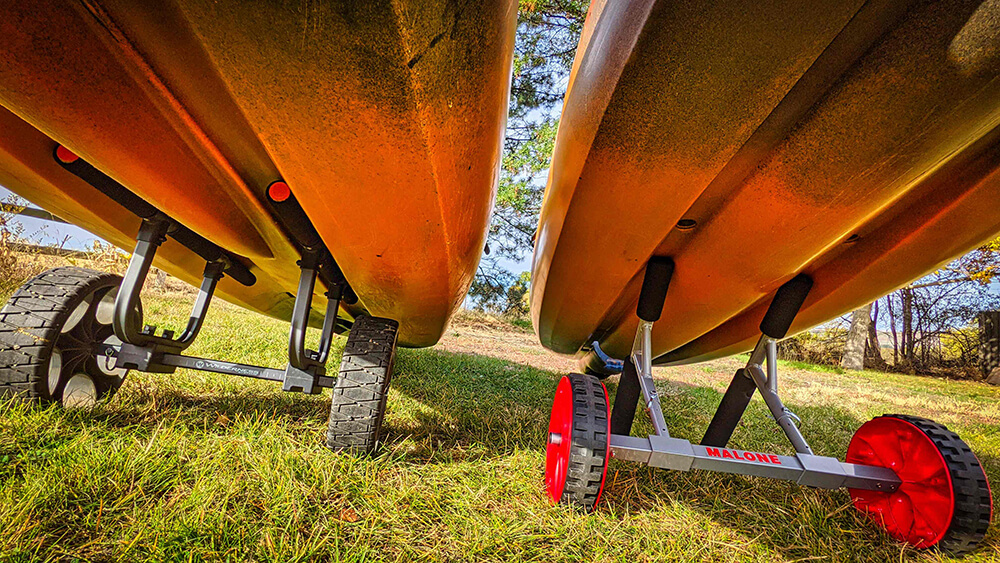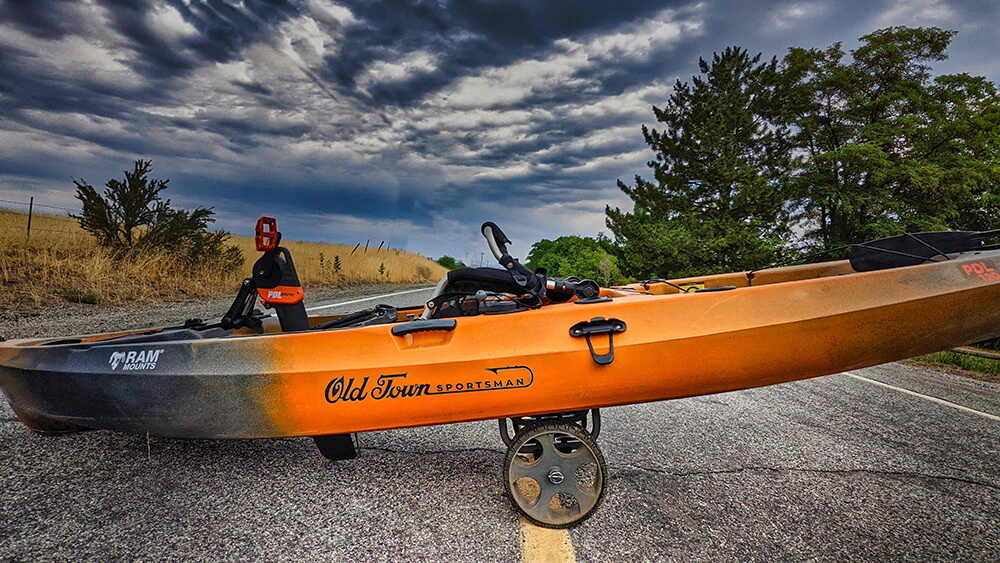A Guide to Fishing Kayak Carts
Transporting a fully loaded kayak or canoe from your vehicle to the launch and back at the end of the day can be one of the most challenging parts of any trip on the water. However, with the use of a kayak cart getting on and off the water is made far easier and safer for you and your watercraft. Additionally, using a cart allows for reduced opportunities for conflict with other users at busy boat ramps and can provide access to unimproved launches more conveniently located closer to your favorite fishing grounds or home.
The Best Kayak Carts for Fishing Kayaks
Two cart designs work best with Old Town canoes and kayaks: bunk-style and saddle-style. Whichever style you select, it's important to make sure your hull is properly supported, and does not place any pressure on the scuppers.
Bunk Style Kayak Carts
The most popular design is the bunk-style carts that work well with Old Town's lineup of sit-on-top fishing kayaks. Bunk-style carts typically have two parallel, padded supports called bunks that rest under the kayak hull. The bunks conform well to the recesses of the pontoon-style hulls that characterize these kayaks, offering a secure and supportive method of transportation.
In addition to the bunks, it's recommended that you secure your kayak to the cart using a cam strap to ensure nothing moves around while transporting.
Our favorite bunk-style kayak cart is the YakAttack TowNStow Bunkster, which is durable, can accommodate heavier fishing kayaks, and breaks down quickly if you need to store the cart in your kayak or vehicle.
Saddle Style Kayak Carts
Another popular design is saddle-style carts that work best with the round hulls of canoes and sit-inside kayaks and are typically more compact and transportable than bunk-style carts. If you're fishing from smaller kayak like the Loon Angler, a saddle style cart is a great option. Saddle style carts are typically smaller and less robust than bunk style carts, so they are not recommended for larger kayaks like the AutoPilot or BigWater ePDL+ 132.
Landing Gear and Scupper Carts - Just Say No!
Two additional cart designs, scupper carts and landing gear, are popular with kayak anglers using sit-on-top kayaks. However, Old Town does not recommend the use of scupper carts with their kayaks as the use of scupper carts may cause damage to the kayak hull. Likewise, the use of landing gear can similarly strain and damage the kayak hull rendering them unfit for use. Use of scupper carts or landing gear on Old Town kayaks and any resulting damage may not be covered by the limited lifetime warranty on the hull.

Key Features for Kayak Carts
Different carts have all sorts of design elements and features that help you get your kayak to and from the water. Here are the key things to look into when considering a cart for your fishing kayak.
Adjustability
Adjustability in the bunk and saddle spacing allows for better customization and fit of your cart to your watercraft. Most carts will come with straps to better secure your watercraft when moving over uneven terrain. Bunk style carts typically allow for height adjustability to accommodate larger kayak cart wheels whereas many saddle style carts do not.
Weight Capacity
Like all transportation accessories, understanding the weight capacity is crucial to selecting the best product for your needs. As fishing kayak have gotten larger and heavier over the last 10 years, so have the kayak carts designed to transport them. It's important to take all components of your fishing kayak (think PDL Drive, seat, battery) and accessories (crates, rods, tackle, safety gear) when calculating the amount of weight you will be transporting.
Heavy duty kayak carts like the YakAttack TowNStow Bunkster can accommodate up to 450 lbs. of gear on a flat, smooth surface. That is more than enough to securely haul your fully loaded fishing kayak to the water. It's important to remember that just because you can transport your fully loaded kayak, you do not have to! The less gear you haul the easier it will be. Consider leaving the heavier components off of the kayak until you're ready to launch, carrying them to the water by hand.
Stowage & Assembly
While this may not be as important as weight capacity and adjustability, understanding how your kayak cart breaks down for storage is important to many kayak anglers. Being able to store your kayak cart inside your kayak means one less trip back up to your vehicle (and more time on the water!) Carts like the YakAttack TowNStow BarCart were designed to quickly and easily break down into a few smaller components that can be stored inside a hatch or in a tankwell. Stowable carts are also essential on trips where portaging is required.
Wheel Type
Carts come with one of two different wheel sizes and materials. The most common are the no-flat wheels typically made with plastic. These durable hard wheels are ideal for moving across hard substrates such as concrete, asphalt, turf, and compact gravel. The no-flats wheels are ideal for those that primarily use improved launches or access to launches with compact surfaces. They are relatively small making them easier to store onboard your watercraft.
For transporting your watercraft across soft sand, loose gravel, and dirt inflatable beach wheels are your best choice. Wider and with a greater diameter, the beach-style wheels won't dig into the substrate making it easier to move your watercraft across these non-compact surfaces. They work well on hard surfaces as well and are more versatile than the no-flat tires but are susceptible to puncture. Additionally, you may need to adjust the bunk or saddle height to accommodate for the wider diameter of balloon-style tires to prevent rubbing on the underside of your watercraft.

Using a Kayak Cart
Proper placement and use of your cart make moving even a fully loaded watercraft easy and painless. A properly placed cart will allow the bulk of the weight to be carried by the cart reducing the amount of energy needed to move the watercraft to and from your vehicle to the launch site. Cart placement will depend on the design of your canoe or kayak and how gear is distributed within it. Ideal placement will be at the fulcrum point and for many popular fishing kayaks that typically fall underneath the seat.
Depending on the design of your watercraft you may find it easier to load it onto the cart from the bow or stern. When loading fully rigged watercraft onto the cart at the end of the day, you may find it easier to slide the cart up underneath your canoe or kayak while it is in the water rather than attempting to lift a heavy and less balanced watercraft at the ramp.
There are many reputable brands producing quality carts that work with Old Town's lineup of canoes and kayaks. Malone, YakAttack, and Ketch have some of the best reputations in the industry and produce a variety of carts that will help get you out on the water easier than ever.






